explore
Andean Highlands - Worldview
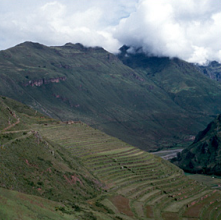
The three basic principles of the Andean worldview existed since ancient times:
- 1. Everything in the universe has a pair
- 2. Nothing can be taken without giving something in return
- 3. A person's livelihood depends on a community of others
These principles were a response to the landscape, and were important to every highland culture.
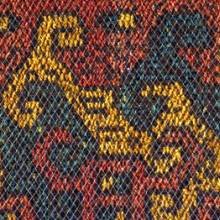
Detail of a woolen belt from the southern highlands c. 700-1000 - a double-faced textile, where the exact pattern repeats on the reverse side in the opposite colours. This pairing of image on front and back, as well as the design with paired interlocking scrolls, is a clear example of the Andean worldview expressed in art. T94.0007
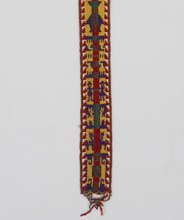
Andeans believed that everything in the universe has a complementary half, and at every level, things are bonded as pairs. Husband and wife, north and south, high and low, positive and negative. Scholars call this type of thinking dualistic. It affected the way Andeans organized their societies. Small communities would come together in pairs for rituals; large states would create huge pairs of provinces. It was also manifested in their art, especially in textiles. Opposites, doubling, and mirroring occurred in ancient textiles, and sometimes occur in contemporary pieces.
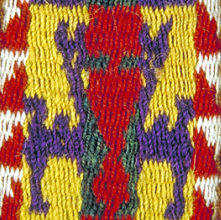
Image: Contemporary Quechua belt from Chahuaytiri, Peru, complementary warp weave. Here a pair of camelids are depicted, as a mirror image. The pattern repeats on the other side of the belt in opposite colours. T02.12.13

Andeans also believed in a system of give and take, which scholars call reciprocity. All things achieved by humans were thought to be at the allowance of the gods. In turn for the good fortune the gods provided, humans were obliged to repay them with prayers, devotion and sacrifices. It was fundamental that the gods be repaid and the balance of give and take preserved.
Image: Illustration by Guaman Poma, a 17th century chronicler of life in Peru, depicting the ritual sacrifice of a llama and the removal of one or more of the animal's organs.
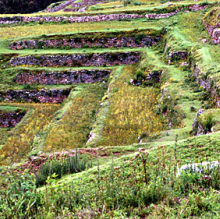
Among the organized, agricultural societies of the highlands, an individual's livelihood depended on larger groups. In order to make a living, highlanders had to tend various crops and herds of livestock up and down the slopes at different elevations. Agriculture on the slopes required extensive terracing and irrigation to increase farmable land, a labour-intensive task. From very early times, Andeans realized that the only way to survive was as a larger community, owning land and sharing labour as a collective.

Image: A system of Inka terraces below the ruins of Chinchero in the southern highlands. Many of the modern buildings in the village of Chinchero, including the Catholic Church, were built upon stone foundations laid by the Inka.